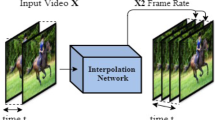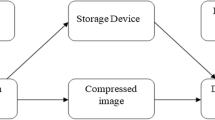Abstract
Recently, distributed source coding (DSC) has been proposed to implement source compression by exploiting source statistics at the decoder only, which enables low-complexity video coding. However, to date, the video codecs based on DSC have been unable to compress as efficiently as traditional predictive video codecs, such as H.264. So, new techniques have to be investigated to improve the performance of the distributed video coding scheme for practical applications. In this paper, I propose a novel distributed video coding scheme based on part intracoding and soft side information estimation. Firstly, at the encoder side, to improve the compression performance of distributed video coding system, we divide the video data into strongly correlative data encoded by Slepian–Wolf codec and weakly correlative data encoded by Intracoding codec. Secondly, at the decoder side, to improve the accuracy of side information estimation, a soft side information estimation method is proposed, which is more suitable for video coding due to the non-stationary feature of video data. Our experimental results show that the performance of our coding system is better than that of the traditional distributed video coding system while keeping the simple encoding property. Also the concept of soft side information is a new idea in distributed video coding and will significantly influence the side information estimation method.










Similar content being viewed by others
References
Aaron A, Girod B (2002) Compression with side information using turbo codes, in Proc. IEEE Data Compression Conference, Snowbird, UT, pp 252–261
Aaron A, Zhang R, Girod B (2002) Wyner–Ziv coding of motion video, in Proc. Asilomar Conference on Signals and Systems, Pacific Grove, CA, pp 240–244
Aaron A, Rane S, Girod B (2004) Wyner–Ziv video coding with hash-based motion compensation at the receiver, presented at the IEEE Int. Conf. Image Processing, Singapore
Aaron A, Rane S, Setton E, Girod B (2004) Transform-domain Wyner–Ziv codec for video. In: Proc. SPIE Visual Communications and Image Processing, San Jose, CA, USA
Aaron A, Varodayan D, Girod B (2006) Wyner–Ziv residual coding of video. Picture Coding Symposium (PCS’2006), Beijing, China
Avudainayagam A, Shea JM, Wu D (2005) A hyper-trellis based turbo decoder for Wyner–Ziv video coding. Proc IEEE Globecom 2005 3:1–6 St. Louis, MO, USA, Nov
Bajcsy J, Mitran P (2001) Coding for the Slepian–Wolf problem with turbo codes. Proc IEEE GlobeCom 2:1400–1404 San Antonio, TX, USA
Bajcsy J, Mitran P (2002) Near Shannon limit coding for the Slepian–Wolf problem, in Proc. Biennial Symposium on Communications, Kingtson, Ontario, Jun
Cheng S, Xiong Z (2005) Successive refinement for the Wyner–Ziv problem and layered code design. IEEE Trans Signal Process Aug:3269–3281. doi:10.1109/TSP.2005.851138
Girod B, Aaron A, Rane S, Rebollo-Monedero D (2005) Distributed video coding. Proc IEEE 93(1):71–83
Guiguang Ding (2007) Wyner–Ziv video coding with Part Intracoding. ICIG 2007, 22–24 Aug, pp 230–234
Liveris A, Xiong Z, Georghiades C (2002) Joint source-channel coding of binary sources with side information at the decoder using IRA codes, in Proc. Multimedia Signal Processing Workshop, St. Thomas, US Virgin Islands, Dec
Liveris A, Xiong Z, Georghiades CN (2002) Compression of binary sources with side information at the decoder using LDPC code. IEEE Commun Lett 6:440–442. doi:10.1109/LCOMM.2002.804244
Pradhan SS, Ramchandran K (1999) Distributed source coding using syndromes (DISCUS): design and construction, in Proc. IEEE Data Compression Conference, Snowbird, UT, pp 158–167
Puri R, Ramchandran K (2003) PRISM: a “reversed” multimedia coding paradigm, Proc. IEEE International Conference on Image Processing, Barcelona, Spain, Sept
Sehgal A, Jagmohan A, Ahuja N (2003) A state-free causal video encoding paradigm, in Proc. IEEE International Conference on Image Processing, Barcelona, Spain, Sept
Slepian D, Wolf J (1973) Noiseless coding of correlated information sources. IEEE Trans Inf Theory 19:471–480. doi:10.1109/TIT.1973.1055037
Varodayan D (2006) http://www.stanford.edu/%7Edivad/software.html
Varodayan D, Aaron A, Girod B (2005) Rate-adaptive distributed source coding using Low-Density Parity-Check codes. In: Proc. Asilomar Conference on Signals and Systems, Pacific Grove, CA
Wang X, Orchard MT (2001) Design of trellis codes for source coding with side information at the decoder. Proc IEEE Data Compression Conf Mar:417–419 Snowbird, UT, USA
Wyner A, Ziv J (1976) The rate-distortion function for source coding with side information at the decoder. IEEE Trans Inf Theory 22:1–10. doi:10.1109/TIT.1976.1055508
Xu Q, Xiong Z (2006) Layer Wyner–Ziv video coding. IEEE Trans Image Process Dec:3791–3803. doi:10.1109/TIP.2006.884925
Zhao Y, Garcia-Frias J (2001) data compression of unknown single and correlated binary sources using punctured turbo codes, in Proc. Allerton Conference on Communication, Control, and Computing, Monticello, IL, Oct
Acknowledgements
The authors acknowledge the support received from the National Natural Science Foundation of China (Project 60502014). Useful comments made by the anonymous reviewers are acknowledged with gratitude.
Author information
Authors and Affiliations
Corresponding author
Rights and permissions
About this article
Cite this article
Ding, G. Distributed video coding based on part intracoding and soft side information estimation. Multimed Tools Appl 41, 183–195 (2009). https://doi.org/10.1007/s11042-008-0224-1
Published:
Issue Date:
DOI: https://doi.org/10.1007/s11042-008-0224-1




